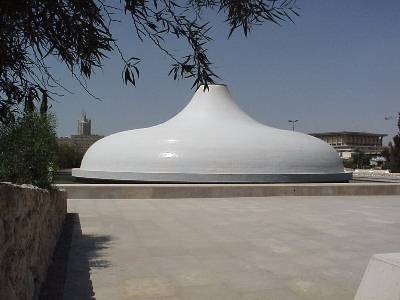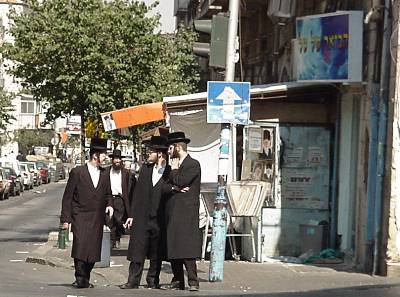 |
 |
 |
 |
This lion orthostat (meaning a large stone that forms the wall of a passage or chamber) was found in the Canaanite city of Hatzor in Galilee. Dated to the fifteenth to thirteenth centuries BC, it now guards the path leading to the archaeology section of the Israel Museum in Jerusalem. The archaeology collection begins with flint tools that are a million and a half years old and continues through the local history, which often corresponds to biblical history. We toured this section of the museum and then the museum's extensive collection of Judaica, items related to Jewish religious and cultural life. |
| Fortifications of the Tower of David weren't
created by King David at all, who ruled during the tenth century BC, but
they do date as far back as the second century BC and were fortified by King
Herod in the late first century BC. Only one of Herod's three original
towers survives. The excavation shown at right, close to the Jaffa Gate of
the Old City of Jerusalem, displays various fortifications added over the
millennia, by Roman troops, monks, Muslims, Crusaders, the Mamluks, and
later the Ottomans.
A fine web site sponsored by the museum gives detailed information about the history of these fortifications and the history of Jerusalem, described with posters and artifacts inside the many corridors of this citadel complex. |
 |
 |
The Shrine of the Book, co-located with the Israel Museum,
houses the Dead Sea Scrolls. These manuscripts were discovered in 1947 by a
pair of Bedouin herders who had entered a cave in search of a stray goat.
The texts are the oldest Hebrew documents that we know, written by the
Essenes, a group of Jews that moved to the desert to live a fundamentalist
form of Judaism. After the first set of scrolls were discovered in one cave,
explorations yielded documents from ten more caves in the area. The holy
documents were written in Hebrew, and others found at the sites were in
Aramaic and Greek.
The building, which appears to be shaped like a chocolate kiss, is actually meant to resemble the funnel-shaped lids of the clay pots in which the documents were found. |
| Yad Vashem, which means "a memorial and a name", honors the six million Jewish victims of the Holocaust and those who risked their lives to save Jews from its terrors. Its various museums and memorial sites present a variety of perspectives. The Garden of the Righteous Among the Nations, for example, honors those who helped to save Jews when so many others stood by, or worse. The Children's Memorial remembers the one and a half million children who perished in the Holocaust. The Valley of the Communities identifies the five thousand Jewish communities that were destroyed and the few that survived. This original cattle car, once used to transport Jews to death camps, is perched over a cliff over a Jerusalem forest, to symbolize the horror, and then a rebirth. | |
 |
When you walk through the ultra-orthodox Jerusalem neighborhood of Me’a She’arim, you are transported to an Eastern European shtetl. The neighborhood was first constructed outside the city walls in 1874. Its residents focus on tradition and religious learning, and are happy to remain segregated from more mainstream Israelis. Signs on the entrances to Me’a She’arim warn against immodest dress, and the locals occasionally take retribution against those who don't take the warnings seriously. The men wear side curls called peyot, long topcoats and broad-brimmed hats (this photo was taken in July) and the women wear long skirts, long sleeves, stockings, and headscarves if they are married. You don't hear Hebrew spoken much in this neighborhood; ultra-orthodox Jews view Hebrew as a sacred language only used for worship. |